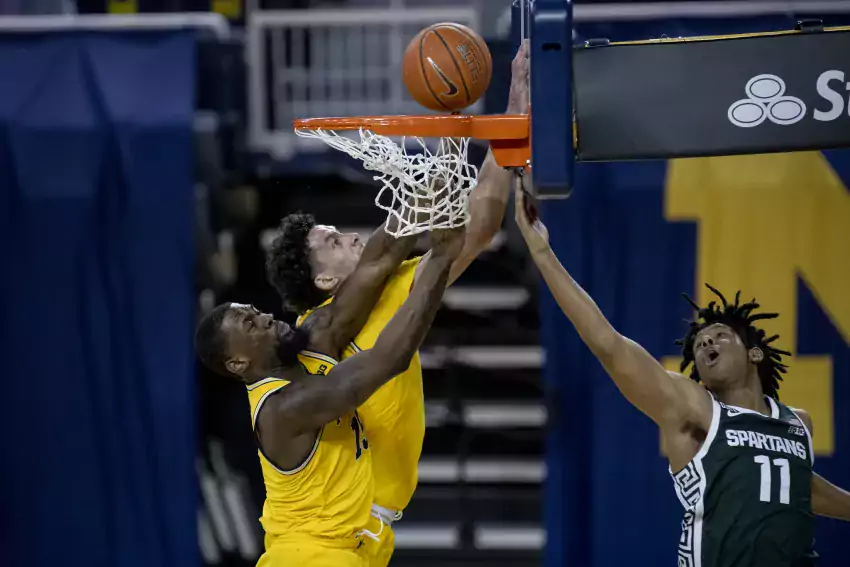
Basketbullets Fills the Void

OUR TOURNAMENT COVERAGE HAS A SPONSOR

The housing market is currently a bit out of control. Finding the right house at the right price is becoming more difficult by the day. That is where Matt Demorest, who runs Simplified Homes with Keller Williams Domain, comes in. You have memorized all his ad copy and the names of his children. If you're reading this, there's a good chance he's bought you a beer. There's no better person to help you buy a home in Michigan.
----------------------
Previously: Examining the Void
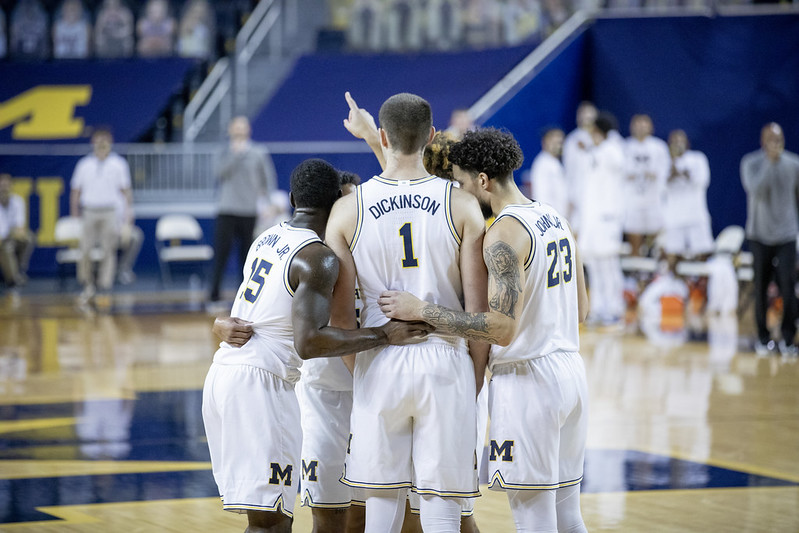
here they come [Campredon]
Yesterday, I covered what Isaiah Livers brought to this team and how his loss could impact their tourney run. Before diving into what his replacements bring to the table, let's refresh our memory on the offensive stats I posted yesterday...
| %Shots | 2PM-2PA | 3PM-3PA | 3P/100 | FTM-FTA | TS% | FTRate | ARate | TO% | |
|---|---|---|---|---|---|---|---|---|---|
| Livers | 21.4 | 52-107 (48.6%) |
50-116 (43.1%) |
9.5 | 47-54 (87.0%) |
60.5 | 24.2 | 11.5 | 11.3 |
| Brown | 21.4 | 37-68 (54.4%) |
32-81 (39.5%) |
10.0 | 14-23 (60.9%) |
57.5 | 15.4 | 5.6 | 13.6 |
| Johns | 17.9 | 29-51 (56.9%) |
6-14 (42.9%) |
3.3 | 22-26 (84.6%) |
63.4 | 40.0 | 7.8 | 25.2 |
| Williams | 17.3 | 10-21 (47.6%) |
1-12 (8.3%) |
5.3 | 9-17 (52.9%) |
39.0 | 51.5 | 3.7 | 16.9 |
...and some additional rebounding and defensive numbers:
| OR% | DR% | Blk% | Stl% | FC/40 | DBPM | DBPR | D-PRPG | |
|---|---|---|---|---|---|---|---|---|
| Livers | 4.5 | 16.6 | 2.3 | 1.1 | 2.0 | 2.9 | 32.3 | 4.1 |
| Brown | 4.8 | 11.2 | 1.4 | 0.4 | 2.8 | 0.7 | 12.8 | 2.3 |
| Johns | 11.8 | 11.8 | 3.1 | 0.9 | 5.5 | 2.1 | 7.8 | 1.3 |
| Williams | 5.8 | 28.9 | 1.5 | 1.3 | 4.2 | 1.6 | 31.4 | 1.1 |
I'll help contextualize the key stats from the above when discussing each player. Which, let's do that.
[...after THE JUMP]
Brandon Johns
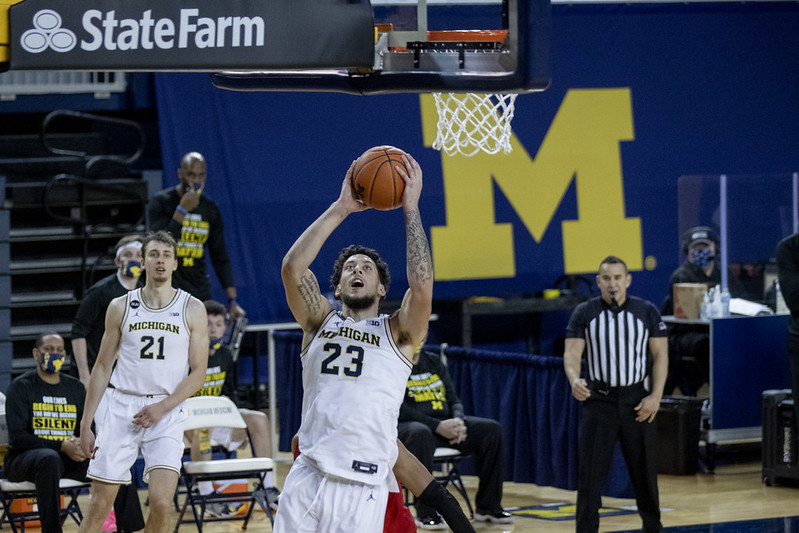
Johns is arguably the best offensive rebounder on the team [Campredon]
Role change: Rotational forward/center to starting power forward
Strengths: Size/athleticism combo, finishing at rim, post scoring, offensive rebounding, rim protection, help defense
Weaknesses: Turnovers, consistency
Jury's out: Spot-up shooting, passing, on-ball defense
A top-75 overall recruit in the 2018 class, Johns is still settling into a role as a junior after bouncing between center and power forward. While Johns has been effective, if enigmatic, he's had his playing time slashed in half this season because of factors mostly outside his control—Livers being healthy (until recently), Chaundee Brown transferring into the sixth man role, Hunter Dickinson coming in ready to play 30+ minutes per game, and so on. There are only so many minutes in a basketball game.
Johns has been open about how he's lost confidence in his game before and this season it feels like he's pressing when he gets his opportunities. He's made improvements in key areas since his sophomore year, particularly passing and offensive rebounding, and he's been a more assertive offensive player, fixing an early-career problem of passing up open shots. He's also turning the ball over and fouling way more than he did before:
| Season | %Min | ORtg | %Shots | OR% | DR% | ARate | TO% | Blk% | FC/40 | FT | 2P | 3P |
|---|---|---|---|---|---|---|---|---|---|---|---|---|
| 2021 | 26.2 | 108.8 | 17.9 | 11.8 | 11.8 | 7.8 | 25.2 | 3.1 | 5.5 | 22-26 (84.6%) |
29-51 (56.9%) |
6-14 (42.9%) |
| 2020 | 46.8 | 112.5 | 14.7 | 7.4 | 15.2 | 3.5 | 13.6 | 3.3 | 2.9 | 34-54 (64.2%) |
44-73 (60.3%) |
19-55 (34.5%) |
On a frequent basis, Johns has moments that make you believe in his NBA potential. There's a certain ease and inevitability to his game when it's coming together:
He can shoot the corner three, attack closeouts, patiently convert putbacks, and go to work in the post—he's generated a 95th-percentile 1.14 PPP on 25 post-up possessions this season, per Synergy. He can pop or roll as the screener in either single ballscreen or double drag sets. He'll break out something he hasn't shown before, like this smooth face-up jumper against Iowa:
This drive-and-kick to (sigh) Livers falls in a similar category. He's also shown nice touch as an entry passer capable of leading the big man away from his defender. He blocks shots and plays solid all-around defense, displaying the versatility to stick with perimeter players and also help secure the paint, sometimes all in one play:
Those flashes, however, have been offset by a lot of unforced errors. His turnover rate has doubled from last year and many of his errors seem to stem from trying to do too much or not being comfortable in his limited minutes; there have been a lot of extra steps, balls booted out of bounds, passes to teammates that vacated the spot a moment earlier, and the like.
There's a lot to be said for the idea that Johns will improve with more consistent minutes. After splitting the stats, it's clear that he's better in games in which he's played more. While there are some cause/effect issues here—as a general rule, one plays more when they're playing well—the results pass the eye test. All rate stats are per 30 minutes, which is a decent approximation of what he'll play without Livers (he got 24 minutes against OSU):
| Minutes | GP | Min | OR/30 | DR/30 | A/30 | TO/30 | Blk/30 | FC/30 | 2PM-2PA | 3PM-3PA | FTM-FTA | PTS/30 |
|---|---|---|---|---|---|---|---|---|---|---|---|---|
| 10 or more | 12 | 164 | 2.2 | 4.0 | 1.5 | 2.2 | 1.3 | 4.0 | 21-30 (70%) |
4-7 | 20-24 | 13.5 |
| 9 or fewer | 12 | 89 | 3.7 | 2.0 | 1.0 | 3.7 | 0.3 | 4.4 | 8-21 (38%) |
2-7 | 2-2 | 8.1 |
Yes, we're working with limited sample sizes, but that's all we've got. In games Johns has played ten or more minutes, he's been much more efficient, productive, and disciplined, while also playing with greater aggression, as the huge gap in free throw numbers shows. The only area he drops off is on the offensive glass and I don't think that'll be a problem with him set to play more as the second man hitting the boards at power forward than as the only big man in small-ball lineups.
One question for Johns is how he'll function as the power forward. Playing a lot of center has pushed most of his shots into two-point range, a big change from his near-even split as a sophomore, but he'll need to be able to space the floor now. While he's not going to fire up threes at the same volume and hit rate as Livers,
Johns is one of the biggest swing players in the tournament. If he's putting up something in the area of 12 points and five boards a game on decent efficiency and playing solid defense, this team can easily make a Final Four run. If he's turning it over four times a game, on the other hand, that reduces the margin for error on a team that's already lost some without Livers available. I'm hoping the Texas Southern game serves as a confidence-builder for Johns to build on the rest of the tourney.
Chaundee Brown

Brown has been a lockdown isolation defender [Campredon]
Role change: Still the sixth man, likely getting a few extra minutes at the three
Strengths: Spot-up shooting, attacking closeouts, isolation defense, turnover avoidance, motor, free throws (career)
Weaknesses: Shot creation, playmaking, causing turnovers, free throws (this season, small sample)
Jury's out: Is his defense great all-around or just eye-catching?
Let's start with Brown's calling card by reputation: his defense. As I mentioned yesterday, I think the advanced defensive metrics are unfairly down on him because he doesn't go for steals/blocks very often. That said, he hasn't been an all-around lockdown defender, struggling in particular against pick-and-roll ballhandlers, per Synergy:
| Play Type | %Time | Poss. | Points | PPP | Rank | eFG% | TO% | %FTs |
|---|---|---|---|---|---|---|---|---|
| P&R Ballhandler | 35.1 | 59 | 51 | 0.864 | 28% | 38.3 | 5.1 | 20.3 |
| Spot Up | 29.8 | 50 | 58 | 1.160 | 13% | 56.4 | 2.0 | 6.0 |
| Off-ball Screen | 12.5 | 21 | 23 | 1.095 | 24% | 55.9 | 9.5 | 9.5 |
| Isolation | 9.5 | 16 | 2 | 0.125 | 99% | 6.7 | 6.3 | 0.0 |
| Hand Off | 7.7 | 13 | 10 | 0.769 | 51% | 38.5 | 0.0 | 0.0 |
| P&R Roll Man | 3.6 | 6 | 6 | 1.000 | — | 50.0 | 0.0 | 0.0 |
| Post-Up | 1.8 | 3 | 2 | 0.667 | — | 33.3 | 0.0 | 0.0 |
There's some needed context to add to the above. Guarded vs. unguarded jumper stats indicate Brown has been very unlucky in terms of opponents drilling well-contested shots, so I'm not worried about his bad spot-up stats—those can swing in a big way on a few three-pointers. When Brown is in isolation situations, which are very good indicators of on-ball defense ability, he's shut down opponents to the tune of 1/15 FG with one turnover on 16 possessions. Our lying eyes aren't always lying.
Still, he's noticeably been a step behind on a number of plays when having to work around screens, which is a bit surprising given his quick feet—I don't think he's as fluid in his hips, so he can get caught up on good picks, which also shows up in his numbers when getting screened away from the ball. He remains a plus defender, particularly for a bench player who also provides good offense, but there are certain situations in which he isn't a terror for opponents.
The good(?) news is Livers also didn't grade out very well against P&R ballhandlers, so this (1) isn't a significant change from the norm and (2) may be a product of Michigan's drop coverage, which encourages shots from the ballhandler over the more efficient looks generated by kickout passes. As a team, the Wolverines grade out in the 21st percentile against P&R ballhandlers and the 70th percentile guarding spot-up possessions. I'm not concerned about Brown as a defender.
On the other end, Brown provides shooting with both volume and accuracy; he's the only Michigan player to attempt more three-pointers per 100 possessions than Livers and he's hit them at a 40% clip. While Livers has a more diverse array of ways to get his shot up and better touch, Brown can replicate a decent amount of his catch-and-fire production, and he's displayed a knack for hitting shots despite strong closeouts:
"Knack" may be an understatement: he grades out in the 98th percentile on Synergy on guarded catch-and-shoot jumpers, making 21/39 shots for 61 points—that's 19 threes and a couple twos. That skill is important when you face teams that don't make many mistakes on the perimeter.
Brown's offense at Michigan has mostly built off his shooting threat. He'll drive when defenders close out too hard and he can finish with either hand. Every once in a while he'll pass the ball out to an open shooter but he's usually driving to score. He doesn't draw a lot of fouls; he's also struggled from the line this season but his career numbers from the stripe are excellent. He'll make some spectacular forays to the offensive glass. He's not a shot creator like Livers but there are other players who can take on those possessions and he takes care of the ball.
Being able to keep Brown as the sixth man is a luxury for Howard. He can see how the game is unfolding before choosing to insert Brown in place of a guard, wing, or big. While the rotation may be tight, Michigan still has a few different looks they can throw at opponents depending on the matchup.
Terrance Williams
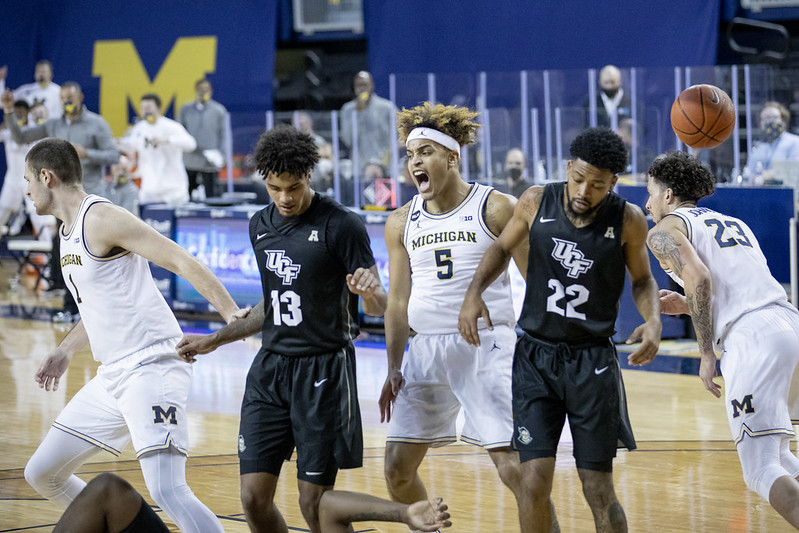
ENERGY GUY [Campredon]
Role change: Out of the rotation to eighth man
Strengths: Motor, rebounding, defensive activity, post entries/synergy with Hunter Dickinson
Weaknesses: Outside shooting, floor spacing, free throws, size in post, freshman stuff
Jury's out: Finishing, team defense, role
It'd be fair to put almost everything in the "jury's out" section given the freshman barely played meaningful minutes during Big Ten play. He's definitely a high-energy player who's going to give good defensive effort and hit the glass on both ends and he has a high comfort level with AAU teammate Hunter Dickinson. While he's generally not passing unless it's to the big man, he can put his head down and finish some tough drives.
Those drives are tough, though, and he struggled to finish them in his handful of opportunities against Big Ten competition. He's also only 9/17 on free throws and 1/12 from beyond the arc. Opponents have not shown any respect for his outside shot; as I discussed yesterday, that's caused severe spacing issues when he's in the game. Here's another example:

Barring a shooting breakthrough, Williams is probably going to be used for spot minutes at most.
More Ways to Adapt
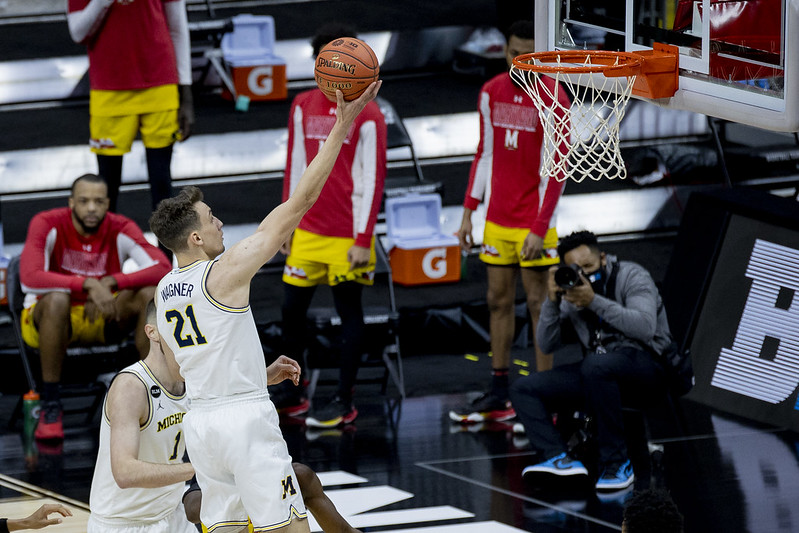
he's probably leaving regardless, let him cook [Campredon]
WAGNER UNLEASHED. In general, I expect Howard to heap more of the playmaking load on the established perimeter creators, which at this point is mostly Mike Smith and Franz Wagner. Smith has already increased his aggressiveness and production down the stretch; now that we know Livers has been dealing with foot issues for a little while, that uptick seems in line with when Livers could no longer play effectively through the injury.
Where Michigan can get more is from Wagner. I'm a broken record about Wagner's potential as an oversized pick-and-roll ballhandler. He's ranked in the 76th percentile as a scorer out of the P&R this season and his passing numbers have been deflated by extremely bad luck on kickouts to shooters. Not a lot of teams have had to deal with a 6'10" wing who can shoot threes, finish at the hoop, and make slick dropoff passes to a skilled giant.
SHORTEN THE BENCH. Coaches tend to tighten their rotation when tournament time comes around but we haven't had the benefit of seeing Juwan Howard in a postseason setting yet. I wouldn't be surprised if the core starters (Smith, Brooks, Wagner, and Dickinson) are playing 35+ minutes per game while Johns, Brown, and (to a lesser extent) Austin Davis get whatever's left barring foul trouble. Johns and Williams have enough overlapping skills that Howard may want to just go with Johns. Saving legs is less of a concern when it's win-or-go-home season.
ZEB? Howard could conceivably go in the other direction and incorporate Zeb Jackson into the rotation to give the team more ballhandling and lineup flexibility. That'd be a surprise given how little he's seen the court but we don't get to see what these guys look like in practice. That said, this is a high-leverage time to find out if a freshman guard is ready to important minutes.
ADAPT THE PLAYCALLING. If, as expected, Johns is going to serve a little more as a second big than Livers did as a pure stretch four, Howard is probably going to need to shift the focus of his offense a bit, at least when Johns is sharing the court with Dickinson or Davis. We may see fewer high ballscreens and double drags in favor of more horns sets and off-ball action that set up high-low situations for the two bigs, which can set up mismatches in the post and put them in position for putbacks.
The Upshot
This is still a dangerous team. I'm far from the only person saying this:
Even without Isaiah Livers, Michigan is still the third best team in our system. They are still very good.
— Evan Miyakawa (@evanmiya) March 13, 2021
This algorithm, which has removed Livers from the projections, has Michigan as the #5 team in the bracket:
Bracket predictions are now live! Check out my prediction table, team ratings, and matchup predictions at https://t.co/v0PHvSEklc pic.twitter.com/8YbOUmvuLX
— Jake Flancer (@JakeFlancer) March 18, 2021
Losing Livers is a blow to the team's title chances; it's not a death knell. A lot depends on the play of Johns and Brown. While neither is as complete a player as Livers, there are plenty of other players on the team capable of taking on slightly bigger roles to help replace his production, and there are a lot of teams in this tournament that'd be starting Johns and/or Brown without a second thought.
Michigan isn't inevitable. They still have the path of a one-seed in a region that could, with some relatively foreseeable upsets, breaks in a way that doesn't require them to pull off anything close to a shocker to reach the Final Four. From there, who knows, especially this year. It's undeniably sad to see Livers most likely end his career watching from the bench in a walking book; he may still captain this team to more banners.
Go, Blue. I'm ready for anything, and hoping for lots.
ZEB? I think you mean, Zeb!
. . . please clap.
I completely agree that we need more Franz, but I just don't think it's gonna happen. It's not the player he is apparently. The 2nd MSU game we needed him to step up for 35 minutes and he didn't step up until the game was out of reach. I'd love to be wrong though
All really good analysis. Great post, Ace! I think the point around adapting the play calling is the critical piece in terms of damage control to offensive efficiency. Spacing is obviously critical to every basketball offense, but especially so for Michigan because the offense is predicated in putting on-ball defenders in high-leverage situations and forcing defenders to make split second decisions. If Johns can consistently hit shots from 3-point range, that allows the offense to keep the cutting and post entry lanes open so the offense can function like it is supposed to. Compared to Livers, Johns is limited in what he can do in terms of creating his own shot and playing the primary ball handler in a 2-man set. However, if he can demand a help defender not to wander too far off from him, I think Franz and Smith can both handle those pick & roll/read possessions that would have gone through Livers.
Obviously Livers is irreplaceable for this team from both a talent and leadership perspective. I do feel however that this will be a bit of a coming out party to some degree for Johns. He absolutely has the skill set to play and athleticism to contribute significant production for a tournament caliber team.
It seems to me that he often looks a bit tight and is thinking too much while he's out there. Some of that mental hurdle for a player can come from knowing that their minutes are scarce and thus places a premium on not making any mistakes that could send them back to the bench, or on the other hand, press too much to persuade the coaches to leave them out there.
With Johns now knowing he is the main option at the four and there's not much competition behind him, he should be playing a lot looser out there and just let the game come to him without forcing anything or looking over his shoulder.
Here's to hoping that how it plays out. I think with competent performances this weekend, Michigan should be able to safely advance to next weekend. Fingers crossed and Go Blue!
March 19th, 2021 at 10:06 PM ^
Brandon Johns would be a starter for just about any other program in the B1G, and most of the NCAA tournament teams. Let's not lose sight of the fact that our "next man up" is a big time talent. I hope he can play free and easy and make this his moment.
The physical differences between Johns and Livers are not significant. There is a significant difference in their basketball IQ...and Livers is a/the primary psychological leader.
Comments